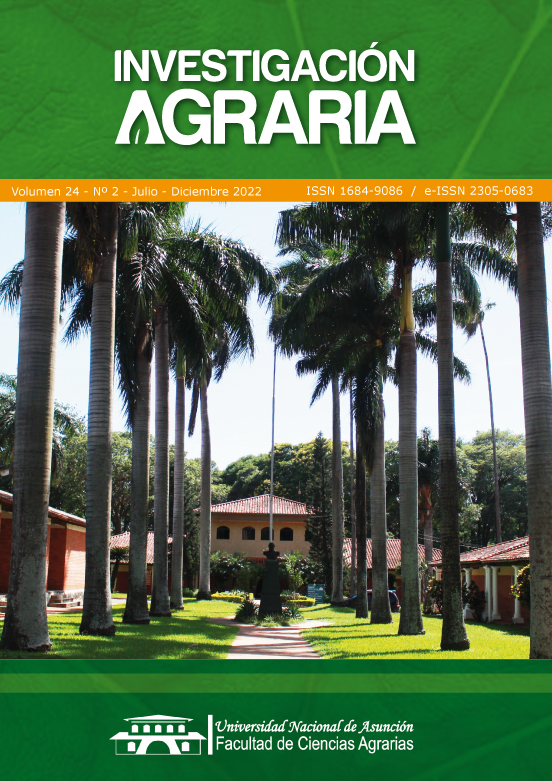Discrimination of vegetation cover in a region of the Cerrado of Mato Grosso through the normalized difference vegetation index
DOI:
https://doi.org/10.18004/investig.agrar.2022.diciembre.2402717Keywords:
NDVI, Remote sensing, GISAbstract
In recent decades, the intensification of the process of replacing the natural vegetation of the Cerrado by areas associated with human activities has caused great impacts on landscapes, in this sense, understanding the dynamics of different environmental systems because of the impacts caused by climate variability and action human, has been the effort of several researchers. Thus, the present work aimed to evaluate the potential of the normalized difference vegetation index (NDVI) applied to LANDSAT 8 satellite images to discriminate vegetation classes in the wet and dry period in a Cerrado region of Mato Grosso. The NDVI values were obtained through the ratio between the difference between the near infrared (ρIV) and red (ρV) reflectivity’s, and the data were processed in the QGIS program version 3.10. The results of this research allow us to conclude that the NDVI vegetation index used allowed the analysis of the vegetation dynamics in Vale do São Lourenço - MT. The vegetation of the study area behaved according to the availability of water in the soil profile, with higher values of the vegetation index in the rainy season and low photosynthetic activity in the dry season.Downloads
Metrics
References
Alvares, C. A., Stape, J. L., Sentelhas, P. C., Gonçalves, J. D. M. & Sparovek, G. (2014). Köppen’s climate classification map for Brazil. Meteorologische Zeitschrift, 22(6), 711-728. doi: 10.1127/0941-2948/2013/0507
Conti, J. B. & Furlan, S. A. (2003). Geologia: o clima, os solos e a biota. En: Ross, J. L. Geografia do Brasil. São Paulo: Edusp, 64-207.
Ferreira, J. M. S., dos Santos Ferreira, H., da Silva, H. A., dos Santos, A. M. & Galvíncio, J. D. (2012). Análise Espaço-Temporal da Dinâmica da Vegetação de Caatinga no Município de Petrolina-PE. Revista Brasileira de Geografia Física, 5(4), 904-922.
Gameiro, S., Teixeira, C. P. B., Silva Neto, T. A., Lopes, M. F. L., Duarte, C. R., Souto, M. V. S. & Zimback, C. R. L. (2016). Avaliação da cobertura vegetal por meio de índices de vegetação (NDVI, SAVI e IAF) na Sub-Bacia Hidrográfica do Baixo Jaguaribe, CE. Terræ, 13(1-2), 15-22.
Godoy, L. P., da Conceição, F. T. & Godoy, A. M. (2016). Aspectos Geológicos da região do Polo Turístico das Águas Termais de São Lourenço, MT. Geociências (São Paulo), 35(1), 110-125.
Júnior, J. J. F. & Dantas, M. J. F. (2018). Análise do albedo da superfície e índices de vegetação por sensoriamento remoto na bacia hidrográfica do rio Pacoti/CE. Revista Tecnologia, 39(2), 1-18. doi: 10.5020/23180730.2018.8132
Landsat 8 Data Users Handbook. (2019). United States Geological Survey. Recovered from: https://www.usgs.gov/core-science-systems/nli/landsat/using-usgs-landsat-level-1-data-product
Lobato, R., Menezes, J., de Lima, L. A. & Sapienza, J. A. (2011). Índice de vegetação por diferença normalizada para análise da redução da mata atlântica na região costeira do distrito de Tamoios–Cabo Frio/RJ. Caderno de Estudos Geoambientais-CADEGEO.
Lourenço, V. R., Ramos, N. N. D. L. A. & Costa, C. A. G. (2017). Distribuição Espaço-Temporal do NDVI sob Condições de Caatinga Preservada. Espaço Aberto, 7(1), 101-110.
MAPABIOMAS (2022). Destaques do mapeamento anual de cobertura e uso da terra entre 1985 a 2021: Cerrado. Disponivel em: https://brasil.mapbiomas.org/soja-ocupa-10-do-cerrado. Acessado em 17/09/2022.
Rouse, J. W., Haas, R. H., Schell, J. A. & Deering, D. W. (1974). Monitoring vegetation systems in the Great Plains with ERTS. NASA special publication, 351(1974), 309.
Sano, E. E., Rosa, R., Brito, J. L. S. & Ferreira, L. G. (2008). Mapeamento Semidetalhado do uso da terra do Bioma Cerrado. Pesquisa Agropecuária Brasileira, 43 (1), 153-156.
Santos, A. M. dos, Galvíncio, J. D. & de Moura, M. S. B. (2008). Aplicação do índice de vegetação por diferença normalizada (NDVI) para identificação da cobertura fitogeográfica da Bacia Hidrográfica do rio Goiana-PE. En: II Simpósio de geografia física do nordeste: sustentabilidade e meio ambiente no nordeste brasileiro, 2008, João Pessoa: Universidade Federal da Paraíba.
Santos, A. M. dos, Galvíncio, J. D., & de Moura, M. S. B. (2010). Os recursos hídricos e as mudanças climáticas: discursos, impactos e conflitos. Revista Geográfica Venezolana, 51(1), 59-68.
Simioni, J. P. D. & Wollmann, C. A. (2016). Comportamento do NDVI obtido por sensor ótico ativo na Estação Ecológica do Taim, RS, no ano de 2009: análise durante o verão, outono, inverno e primavera. Revista Interface (Porto Nacional), 11(11).
Souza, D. F. de, Gonzalez, G. D. D. & Teixeira Filho, J. (2019). Variação temporal do índice de vegetação normalizada como ferramenta de identificação dos açudes na bacia hidrográfica do Ribeirão das Cabras. Revista Cerrados (Unimontes), 17(1), 222-239. doi: 10.22238/rc2448269220191701222239
Tarifa, J. R. (2011). Mato Grosso: clima – análise e representação cartográfica. Cuiabá: Entrelinhas, 69-96
Published
How to Cite
Issue
Section
License
Copyright (c) 2023 Pedro Paulo Gomes de Oliveira, Deyse Scorpioni de Oliveira, Paulo Costa de Oliveira Filho, Rafael Delgado Martínez, Hugo Armando Barúa Acosta, Jackeline Vieira dos Santos Laroca, Mateus Miranda de Oliveira

This work is licensed under a Creative Commons Attribution 4.0 International License.
All content in this journal is under Creative Commons Attribution License.









 All content in this journal is under
All content in this journal is under 